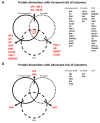Novel Biomarkers Detected by Proteomics Predict Death and Cardiovascular Events in Hemodialysis Patients
- PMID: 35453489
- PMCID: PMC9026983
- DOI: 10.3390/biomedicines10040740
Novel Biomarkers Detected by Proteomics Predict Death and Cardiovascular Events in Hemodialysis Patients
Abstract
End-stage kidney disease increases mortality and the risk of cardiovascular (CV) disease. It is crucial to explore novel biomarkers to predict CV disease in the complex setting of patients receiving hemodialysis (HD). This study investigated the association between 92 targeted proteins with all-cause death, CV death, and composite vascular events (CVEs) in HD patients. From December 2010 to March 2011, 331 HD patients were included and followed prospectively for 5 years. Serum was analyzed for 92 CV-related proteins using Proseek Multiplex Cardiovascular I panel, a high-sensitivity assay based on proximity extension assay (PEA) technology. The association between biomarkers and all-cause death, CV death, and CVEs was evaluated using Cox-regression analyses. Of the PEA-based proteins, we identified 20 proteins associated with risk of all-cause death, 7 proteins associated with risk of CV death, and 17 proteins associated with risk of CVEs, independent of established risk factors. Interleukin-8 (IL-8), T-cell immunoglobulin and mucin domain 1 (TIM-1), and C-C motif chemokine 20 (CCL20) were associated with increased risk of all-cause death, CV death, and CVE in multivariable-adjusted models. Stem cell factor (SCF) and Galanin peptides (GAL) were associated with both decreased risk of all-cause death and CV death. In conclusion, IL-8, TIM-1, and CCL20 predicted death and CV outcomes in HD patients. Novel findings were that SCF and GAL were associated with a lower risk of all-cause death and CV death. The SCF warrants further study with regard to its possible biological effect in HD patients.
Keywords: biomarkers; cardiovascular disease; death; hemodialysis; proteomics.
Conflict of interest statement
The authors declare no conflict of interest.
Figures





References
-
- de Filippi C., Wasserman S., Rosanio S., Tiblier E., Sperger H., Tocchi M., Christenson R., Uretsky B., Smiley M., Gold J., et al. Cardiac troponin T and C-reactive protein for predicting prognosis, coronary atherosclerosis, and cardiomyopathy in patients undergoing long-term hemodialysis. JAMA. 2003;290:353–359. doi: 10.1001/jama.290.3.353. - DOI - PubMed
LinkOut - more resources
Full Text Sources

